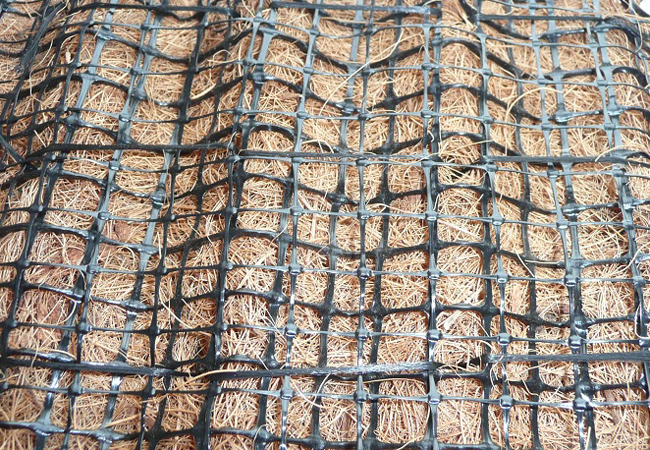Geotextiles/Turf Reinforced Mats

Description
Geotextiles are porous fabrics known in the construction industry as filter fabrics, road rugs, synthetic fabrics, construction fabrics, or simply fabrics. Geotextiles are manufactured by weaving or bonding fibers made from synthetic materials such as polypropylene, polyester, polyethylene, nylon, polyvinyl chloride, glass and various mixtures of these. A subset of geotextiles includes Turf Reinforced Mat (TRMs). TRMs combine vegetative growth with synthetic materials to form a high-strength mat that helps prevent soil erosion in drainage ways and on steep slopes. Additionally, erosion control mats can be manufactured from coconut fibers (coir) with added strength by including polypropylene fibers.
Purpose
As a synthetic construction material, geotextiles are used for a variety of purposes in the United States and other countries. The uses of geotextiles include separators, reinforcement, filtration and drainage, and erosion control.
Where Practice Applies
Geotextiles, when used alone, can be used as matting. TRMs are used to stabilize the flow in channels and swales. TRMs may also be used on recently planted slopes to protect seedlings until they become established and on tidal or stream banks where moving water is likely to wash out new plantings.
Geotextiles are also used as separators. An example of such a use is geotextile as a separator between riprap and soil. This ‘sandwiching’ prevents the soil from being eroded from beneath the riprap and maintaining the riprap’s base. TRMs are classified as a soft engineering approach as opposed to concrete and riprap. TRMs are composed of interwoven layers of non-degradable geosynthetic materials such as polypropylene, nylon, and PVC netting, and are usually stitched together to form a three-dimensional matrix. Soil can be placed in the TRM which allows for vegetative root growth and soil stabilization or the mat can be placed on the soil surface. TRM technology can be used in conjunction with temporary sediment and erosion control measures to re-establish vegetation at construction sites.
TRM s are used to stabilize soil on steep slopes, to prevent scouring in stormwater detention ponds, small open channels, drainage ditches, and runoff conveyance systems associated with parking lots and other impervious surfaces.
Advantages
- Fabrics are relatively inexpensive for certain applications as opposed to concrete and riprap
- A wide variety of geotextiles to match specific needs is available.
- Natural fibers such as coconut can be woven into mats for erosion control.
- The result is a stabilized vegetated slope or swale.
Disadvantages/Problems
- If the fabric is not property selected, designed, or installed, the effectiveness may be reduced drastically.
- Many synthetic geotextiles are sensitive to light and must be protected prior to installation.
Planning Considerations
- There are numerous types of geotextiles available; therefore the selected fabric should match its purpose. In the field, important concerns include regular inspections to check for cracks, tears, or breaches in the fabric or mat.
References
U.S. Environmental Protection Agency, Storm Water Management For Construction Activities, EPA-832-R- 92-005, Washington, DC, September, 1992.
U.S. Environmental Protection Agency, Stormwater Technology Fact Sheets – Turf Reinforced Mats. EPA 832-F-99-002, September 1999.
Connecticut Council on Soil and Water Conservation. 2002 Connecticut Guidelines for Soil Erosion and Sediment Control. DEP Bulletin 34.